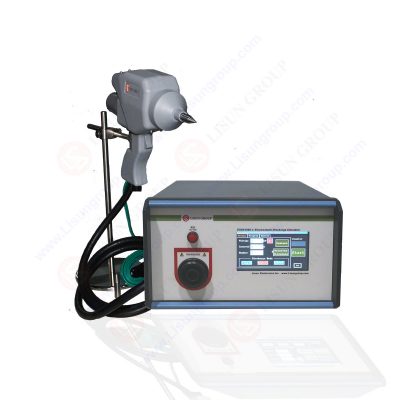
An electrostatic discharge generator is a device used to simulate and test the tolerance of electronic devices and systems to electrostatic discharge (ESD) environments. By simulating the amplitude, frequency, and waveform of electrostatic discharges, it can replicate ESD events in real-world environments to validate the durability and performance of equipment.
Components of an Electrostatic Discharge Generator:
Power Supply:
Provides the electrical energy required for the entire system, serving as the core component of the electrostatic discharge generator.
High Voltage Generation Circuit:
• Generates predetermined electrostatic discharge waveforms through amplification and waveform shaping.
• Utilizes transformers and rectifier circuits to convert the power supply voltage into high-voltage electricity.
Storage Capacitors:
• Store high-voltage electrical energy.
• Capacitors discharge stored energy during discharge events, simulating electrostatic discharge events.
Contact Devices:
• Connect with the device or system under test to release stored electrical energy.
• Include discharge electrodes and grounding systems to simulate different discharge scenarios (such as contact discharge and air discharge).
Control System:
• Controls the timing, amplitude, and frequency of electrostatic discharges to ensure test controllability and repeatability.
• Includes manual and automatic control modes, allowing users to set various test parameters.
Display System:
• Real-time display of voltage, current, and other relevant parameters during testing.
• Assists users in monitoring and recording the testing process.
ESD61000-2_Electrostatic Discharge Simulator
Principles of Operation of an Electrostatic Discharge Generator:
Energy Storage:
• The power supply provides electrical energy to the high voltage generation circuit, which raises the voltage to a predetermined level and stores the energy in storage capacitors.
Voltage Adjustment and Waveform Shaping:
• The high voltage generation circuit generates ESD waveforms conforming to standards by adjusting voltage and shaping the waveform.
Discharge Preparation:
• The control system sets the time, amplitude, and frequency of discharges.
• Contact devices (discharge electrodes) make contact or approach the device under test, preparing for discharge.
Discharge Process:
• When the set conditions are met, storage capacitors rapidly discharge electrical energy, applying high-voltage energy to the device under test through contact devices, simulating electrostatic discharge events.
Monitoring and Recording:
• The display system monitors and records voltage, current, and other parameters during the testing process.
• Users can assess the tolerance and performance of the device under test based on the displayed data.
Conclusion:
The electrostatic discharge generator assists in evaluating and validating the tolerance of electronic devices and systems to electrostatic environments by simulating real-world ESD events. Its core components include a power supply, high voltage generation circuit, storage capacitors, contact devices, and control and display systems. Through precise control and monitoring, the electrostatic discharge generator ensures the reliability and repeatability of tests, providing essential guidance for the anti-static design of electronic equipment.
Primary Applications of Electrostatic Discharge Generator:
The electrostatic discharge generator is widely used in ESD testing of various electronic devices, products, equipment, and materials. By simulating real-world ESD events, it evaluates the reliability and durability of these objects. The main applications include:
ESD Testing of Electronic Devices:
• Integrated circuits, semiconductor components, sensors, etc.
• Assessing the reliability and durability of electronic components under ESD conditions.
ESD Testing of Electronic Products:
• Mobile phones, computers, monitors, home appliances, etc.
• Ensuring product safety and reliability during normal use by simulating ESD scenarios.
ESD Testing of Electronic Equipment:
• Automation equipment, industrial computers, instruments, medical devices, etc.
• Guaranteeing the reliability of devices under harsh industrial environments by testing ESD tolerance.
ESD Testing of Electronic Materials:
• Insulating materials, conductive coatings, packaging materials, etc.
• Evaluating the behavior of materials under electrostatic discharge conditions to ensure suitability for ESD-sensitive electronic products and components.
Usage Steps of Electrostatic Discharge Generator:
When using an electrostatic discharge generator for ESD testing, follow a series of steps to ensure accuracy and safety. Detailed steps include:
Connect Testing Equipment:
• Prepare connections to avoid accidental discharge.
• Ensure stable and reliable connections between the electrostatic discharge generator and the device under test. Choose appropriate contact devices (e.g., contact discharge electrodes or air discharge electrodes) based on testing requirements.
• Check grounding to avoid interference and ensure accurate test results.
Set Parameters:
• Select ESD waveforms and adjust discharge voltage according to testing requirements.
• Set discharge frequency as per needs.
• Confirm other parameters (such as discharge times, interval times, etc.).
Perform Testing:
• Double-check all connections and parameter settings.
• Initiate testing by triggering the discharge switch on the electrostatic discharge generator to release stored energy and perform discharge.
• Observe the reaction of the electrostatic discharge generator and the device under test to ensure smooth discharge processes.
Record and Analyze Results:
• Record device responses and performance changes after electrostatic discharge during testing.
• Analyze recorded data to assess ESD tolerance.
• Adjust parameters if necessary and repeat testing to validate device tolerance.
In Summary:
The usage steps of an electrostatic discharge generator include connecting testing equipment, setting parameters, performing testing, and recording and analyzing results. Each step requires careful operation to ensure accuracy and safety. Through these steps, it’s possible to effectively evaluate the ESD tolerance of electronic devices and systems, ensuring product reliability and safety.
https://www.lisungroup.com/news/technology-news/principles-and-components-of-electrostatic-discharge-generator.html
.jpg)
Comments
Post a Comment